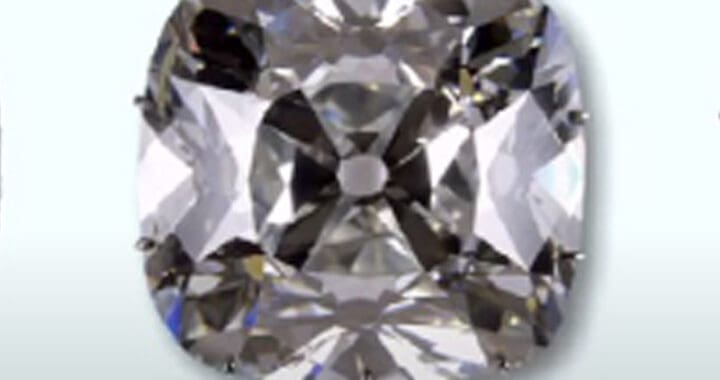Download this article here
Henri IV and his wife Catherine de Medicis decided to rebuild and add to the collection of the Crown jewels. Nicolas Harlay de Sancy was in charge of Henri IV finances. He owned two diamonds which he purchased from the King of Portugal. He recut these and named them Grand Sancy and Beau Sancy. He offered to sell the Sancy to Henri IV who declined stating it was too expensive. Instead, he bought the Beau Sancy.
The diamonds most likely came from India and could have been part of the jewels belonging to Charles the Bold, Duke of Burgundy 1467-1477. Amongst his jewels were the White Rose diamond. It is rumoured the Sancy could be the same stone.


The Beau Sancy, K colour, light brown, SI1 clarity, type IIa (type IIa diamonds are chemically “cleaner” and often have exceptional clarity) weighing 34.98 carats. In 1610, Marie de Medicis had the Beau Sancy set atop her coronation crown.
The following day, Henri IV was murdered by Ravaillac. For four centuries the diamond was owned by several European Royal houses, such as the House of Medici, Kings of England and Prussia. It was sold by Sotheby’s in 2012 for £5.3 million to a private collector.
The Sancy weighs 55.23 carats. It has 51 facets and was considered to be one of the most beautiful diamond for almost two centuries until the Cullinan was found in 1905 in South Africa.
It was purchased by James I for 60,000 French crowns and was set in the Mirror of Great Britain.

The Sancy was described in the Tower of London’s inventory as “…one fayre dyamonde, cut in fawcetts, bought of Sauncy…”
The Sancy was briefly owned by Charles I, King of England and then by his son James II. James had to flee to France under Louis XIV protection and brought with him the Sancy which he agreed to sell to Cardinal Mazarin in 1657 for £25,000.

Cardinal Mazarin was advisor to the young Louis XIV. Incredibly wealthy with a fortune said to be worth 22 tonnes of gold, he purchased gems and jewels which he will then bequeath to Louis XIV on his death with the condition that these could not be sold, had to remain all together and would be called the “Mazarins”.

Amongst those were 12 stones which he purchased from Henrietta Maria, Queen Consort of England, wife of Charles I in exile from England. These stones are the foundation of the 18 “Mazarins”.

Louis XIV added to his collection by purchasing the Diamant de Guise in 1665 and in 1673 the Hortensia diamond, a pink 21.32 carat diamond.
Most, if not all diamonds came from India, more accessible than Borneo where diamonds were also found. During one of his last trips, Jean-Baptiste Tavernier brought back the “Tavernier Blue” which became the “Grand bleu de Louis XIV”. It weighed approximately 115.40 carats.

It was stolen in the great theft of 1792 and recut, down to 69 carats. It is said to be the well-known cursed Hope diamond, recut to prevent proper identification.
Tavernier also brought back the Grand Sapphire of Louis XIV, of Ceylon origin. The king purchased it in 1669 and weighs 135.80 carats. It was believed that sapphires could cure plagues which is why it was never cut. I is exhibited in Paris.
In 1691 an inventory was drawn up stating that there were: 5,885 diamonds, 1,588 coloured gems, 488 pearls adding to a total of 11,430,481 pounds.
The Regent diamond was added to the collection a few years later, bought by the Duke of Orléans in 1717, then Regent of France, for £135,000 (the equivalent of £21 million). It had taken two years to cut, 1703-1705, and finally weighed 140.64 carats.

It was considered to be the most beautiful and clean diamond, until the Cullinan, becoming a symbol of the French crown.
In 1722, the Regent was set at the front of Louis XV coronation the crown, the Sancy at the top of the fleur-de-lys alongside Mazarin diamonds.
It was subsequently set in Louis XVI coronation crown in 1775. In 1791 is was valued at £480,000 (the equivalent of £58 million).
Having won the Campagnes d’Italie (wars in Italy), a superstitious Napoleon had the Regent set in his sword in 1812, convinced it had made him win the wars. It was later set in Princess Eugenie’s diadem in 1825.


Aurélia has over twenty years’ experience in the auction industry. She started her career in Business Development and Client Services at Christie’s and Sotheby’s Paris.







